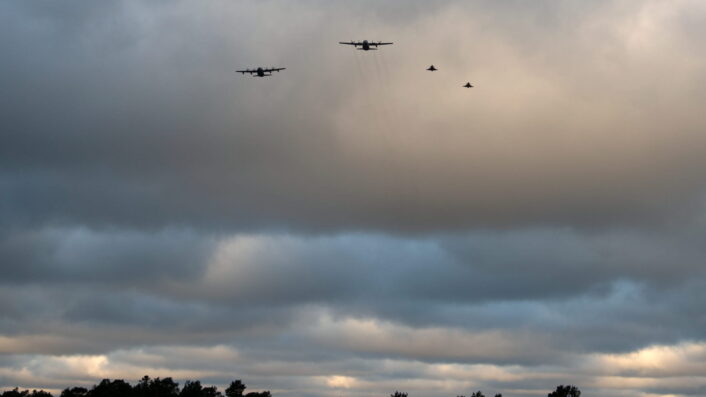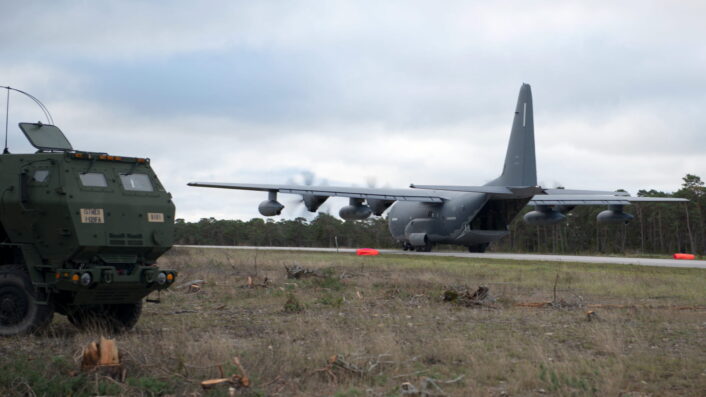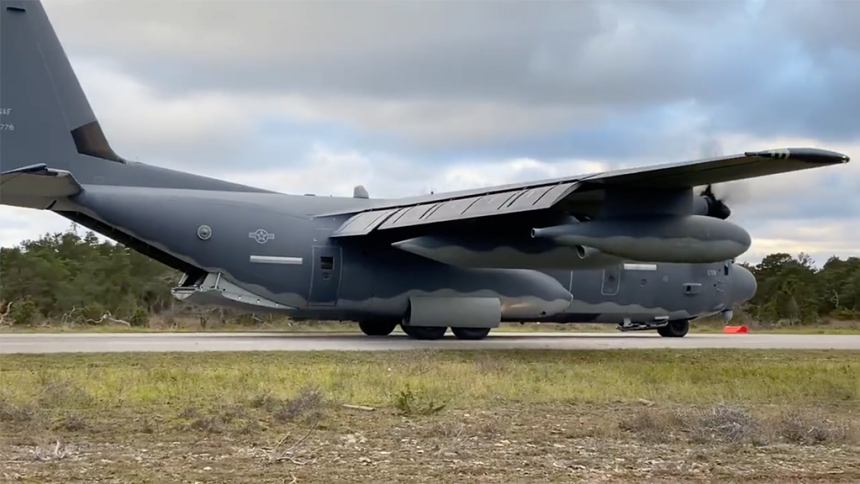The MC-130J Commando II Special Operations aircraft unloaded an M142 High Mobility Artillery Rocket System that was then loaded onto a Swedish C-130 during recent drills on Gotland island.
A really interesting training mission was carried out on Saturday Oct. 23, 2021, in Sweden, where a U.S. Air Force Special Operations Command MC-130J Commando II aircraft landed on a highway on Gotland, Sweden’s largest island, strategically located in the the Baltic Sea.
The American Special Operations aircraft arrived over the road segment used for the drills in formation with a Swedish Air Force C-130H (locally designated TP 84) and two Swedish JAS 39 Gripen jets.

After the road landing, the MC-130J, belonging to the 67th Special Operation Squadron of the 352d Special Operations Group (352 SOG) from RAF Mildenhall, UK, unloaded an M142 HIMARS (High Mobility Artillery Rocket System).
#Now U.S. Special Operations aircraft lands in highway near Visby, Gotland 🇸🇪 with an exceptional cargo #SoFinEurope pic.twitter.com/W4Ii8ddtr0
— US Spec Ops Europe (@US_SOCEUR) October 23, 2021
The HIMARS rocket artillery system is a light multiple rocket launcher developed in the late 1990s for the United States Army, mounted on a truck frame and carrying six rockets or one MGM-140 ATACMS missile.
The HIMARS system was then loaded onto the Swedish TP 84.
And perhaps even more interesting, the #HIMARS was then loaded onto a Swedish C-130H Hercules (local designation TP 84) and moved to another location in Sweden. h/t @GripenNews #turpo=#säkpol https://t.co/UycesACQIR
— Corporal Frisk (@CorporalFrisk) October 23, 2021
According to the Swedish MOD, the highway landing and M142 unloading/loading operation with the HIMARS was part of a Swedish-led special forces exercise currently underway in southern Sweden and on Gotland, where operational and tactical command and coordination of several parallel combat and intelligence operations are being practiced and developed.
“We have taken further steps in the cooperation with the U.S., where we, with American military transport aircraft, have moved a long-range artillery system to Gotland, reloaded to a Swedish military aircraft for further transport within Sweden. The opportunity to act with this and other types of ground or airborne weapon systems together with our partners, I believe removes any doubts about our common ability to be a guarantor of security in the Baltic Sea area” said Special Forces Command, Brigadier General Anders Löfberg.

Although Sweden has a longstanding policy of political neutrality and is not part of NATO treaty, it is a participant in the Euro-Atlantic Partnership Council and regularly takes part in joint exercises with the U.S. and the rest of the western allies. During the Cold War, the Swedish government secretly made preparations to receive military aid from the United States in case of Soviet aggression.
Gotland island, in particular, is considered extremely strategic in the region, so much so it’s considered as “a fixed aircraft carrier in the Baltic”. Last year, The Swedish military had to deploy four naval warships and an unspecified number of ground forces and warplanes in response to a major Russian naval exercise that also included a simulated amphibious landing set off regional alarms. U.S. Special Operations aircraft regularly operate in Sweden and Gotland and it seems more than likely it will be even more the case in the future.
Dealing with the MC-130J Commando II, here are some details about the aircraft we posted in 2017, when some photos released by the U.S. DoD proved that the multimission combat transport/special operations tanker had joined OIR (Operation Inherent Resolve) against the Islamic State in Iraq and Syria.
The MC-130J Commando II, that has replaced the MC-130N/P Combat Shadow II aircraft, is the modern special operations variant of the Hercules, whose primary roles are HAAR (Helicopter Air-to-Air Refueling) of SOF helicopters/tilt rotor aircraft, infiltration, exfiltration and resupply of SOF by airdrop or landing on remote airfields. Interestingly, the aircraft can also be used for FARP (Forward Air Refueling Point) operations to perform covert, nighttime refueling operations in deployed locations where fueling stations are not accessible or when air-to-air refueling is not possible.
The MC-130Js mainly operate at low-altitude and at night, conducting clandestine missions with reduced probability of visual acquisition and intercept by airborne threats.
According to the U.S. Air Force, the MC-130J features an advanced two-pilot flight station with fully integrated digital avionics; fully populated Combat Systems Operator (CSO) and auxiliary flight deck stations; 13 color multifunctional liquid crystal displays; head-up displays; fully integrated navigation systems with dual inertial navigation system and global positioning system; integrated defensive systems; low-power color radar; digital moving map display. The aircraft is equipped with new turboprop engines with six-bladed, all-composite propellers; digital auto pilot; improved fuel, environmental and ice-protection systems; enhanced cargo-handling system; Universal Air Refueling Receptacle Slipway Installation (UARRSI), air refueling pods, Electro Optical/Infrared (EO/IR) System; dual SATCOM for voice/data; 60/90 KVA generators; increased DC electrical output, loadmaster/scanner restraint system; and LAIRCM provisions.









